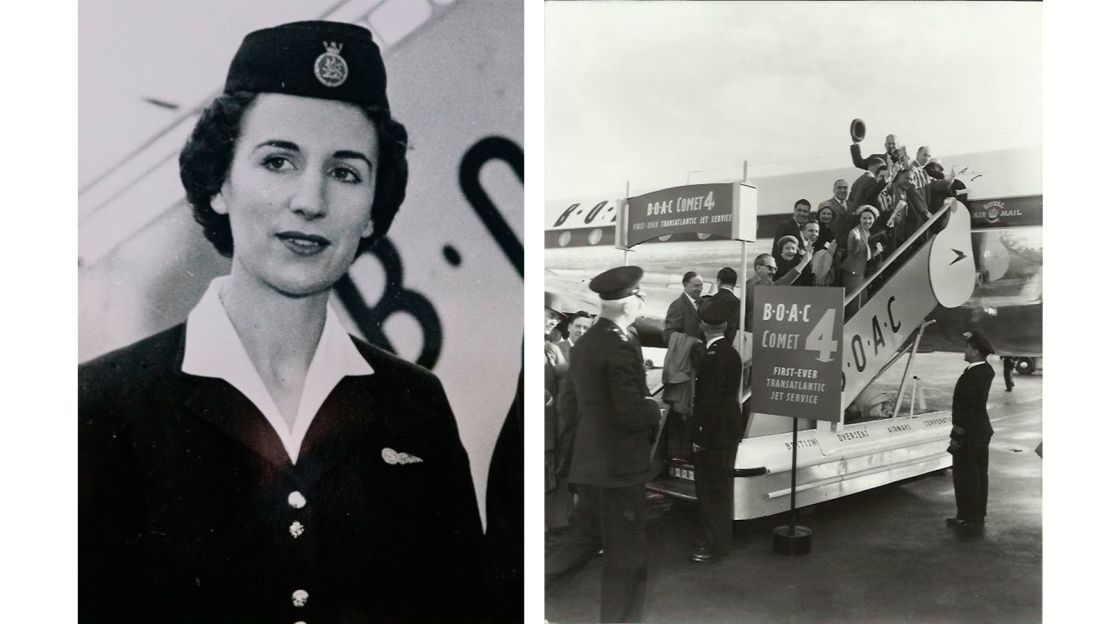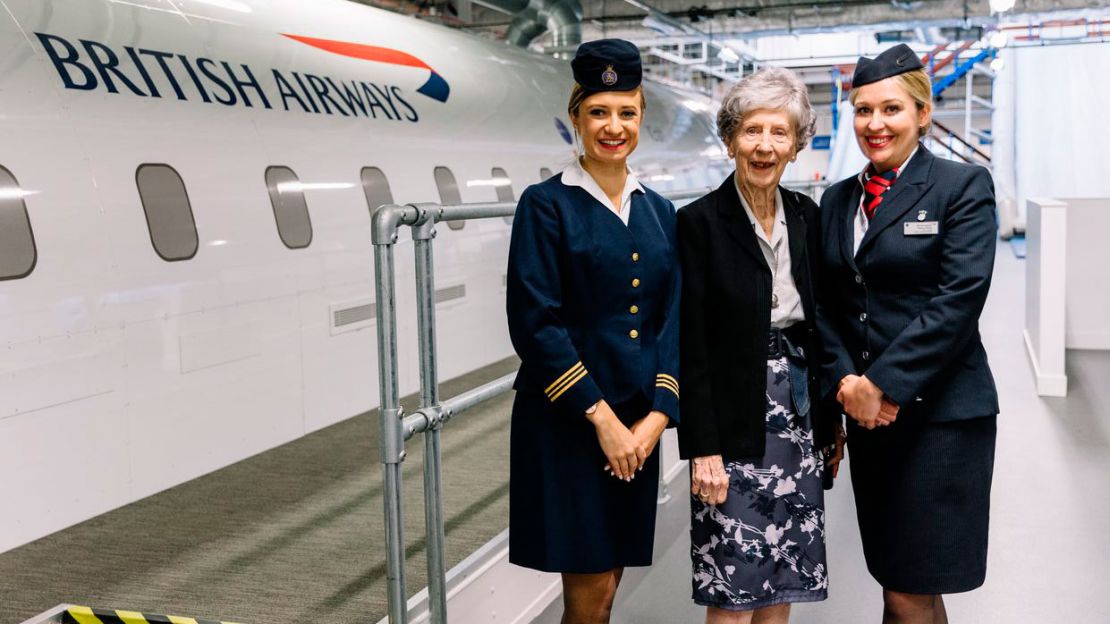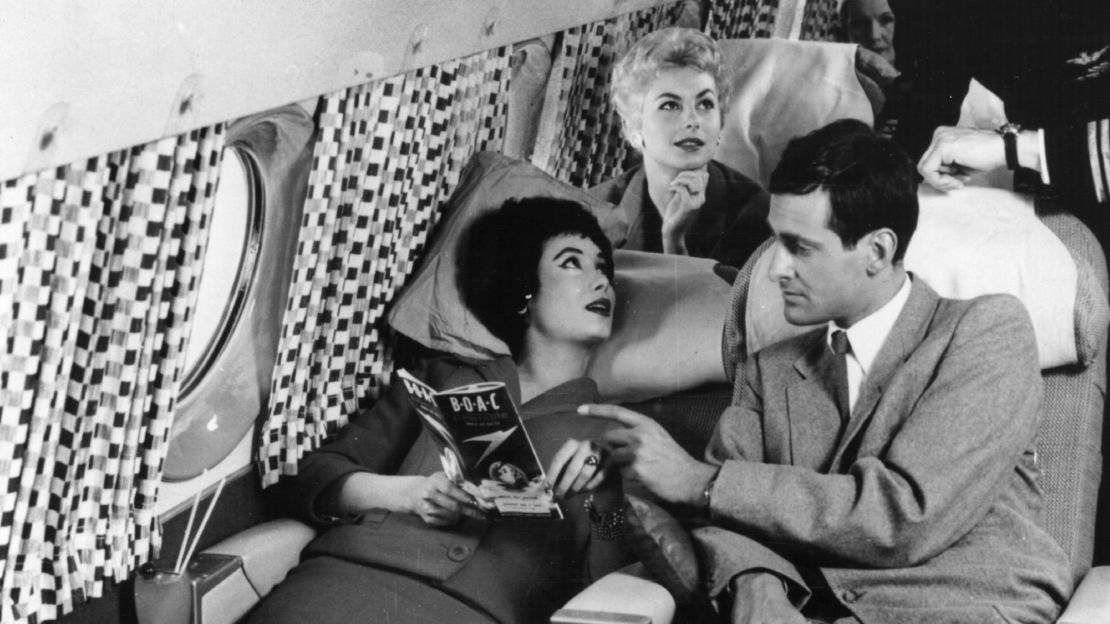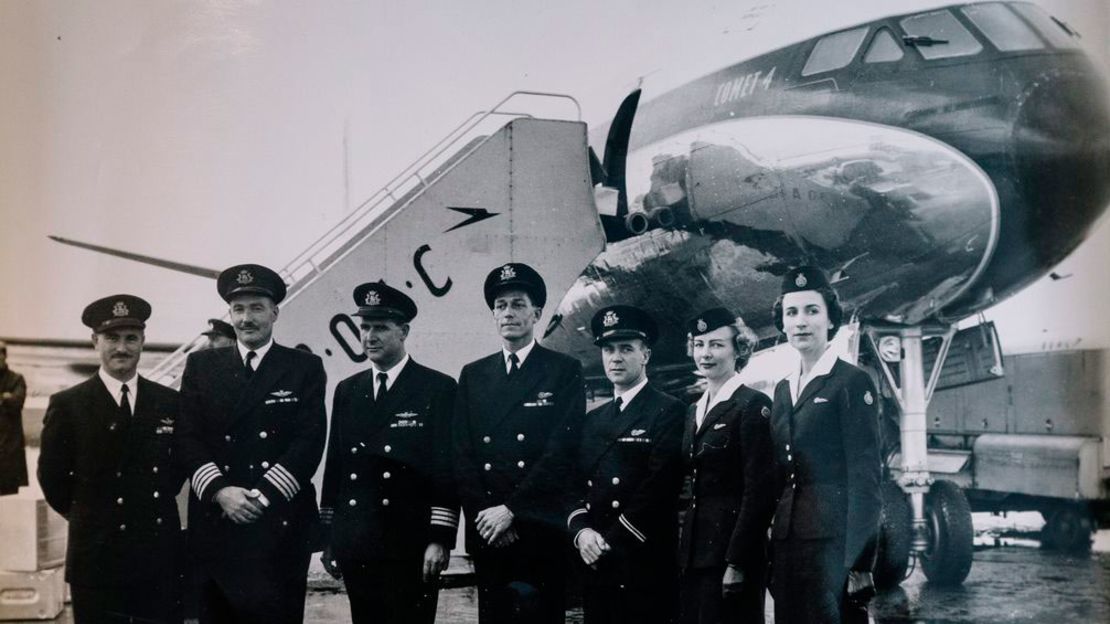What was it like to travel on the first passenger flight of a trans-Atlantic jetliner?
Former British Overseas Airways Corporation air steward Peggy Thorne, 91, says the experience was unforgettable.
“It was exciting, it really was,” she tells CNN Travel at British Airways HQ’s Heritage Center, where she’s guest of honor at the airline’s 60th anniversary of this aviation milestone.
British Airways’ predecessor BOAC flew the first turbo jet engine aircraft – the British de Havilland Comet 4 – from New York to London and London to New York on October 4, 1958. Thorne worked on board the eastbound flight.
Airplanes had been criss-crossing the Atlantic since the 1930s – with BOAC rival Pan American inaugurating the world’s first trans-Atlantic passenger service in June 1939.
But before 1958, these trans-Atlantic flights took up to 20 hours, with several stops along the way. The BOAC milestone achievement cut this lengthy journey to the roughly 7-hour direct stint we’re familiar with today.
Amazing experience

As a young woman, Thorne had a thirst for adventure. It was this desire to explore the world that led her to become a flight attendant.
“I suppose in the 1950s, there were not a lot of opportunities to travel, and I was then a secretary in the foreign office, so I’d seen a bit of the world,” she recalls. “And I thought, I don’t know, it seems a lot more interesting than what I’m doing now and so I applied, joined, stayed throughout my career.”
Thorne says the tasks she did on board flights were pretty much exactly what air stewards do today – and she would know, in the lead up to the anniversary celebrations, Thorne spent the day with British Airways cabin crew members doing their training on flight simulators.
“I was so impressed with the way it was laid out with the mock-ups of the aircraft, because in the dark ages when I did my training, I don’t think we had an aircraft to train on,” she laughs.

One big difference was that air travel in the mid-twentieth century was still very much an opulent, luxurious affair.
“On the Comet 4, when it first came in, of course, it was all super luxury, reclining chairs, first class silver service,” says Thorne. “But I mean its service otherwise has not changed a great deal.”
Customers enjoyed cocktails and canapes, a five-course lunch with wines and afternoon tea.
Rich and famous

On the New York-London route, Thorne met many fascinating, often famous figures – perhaps unsurprising when you consider nabbing a seat on one of these flights would set you back the equivalent of over $1000.
“It was such a novel thing, so people coming up the steps you’d recognize them – film stars and diplomats and people – and obviously they wanted to be the first to be on this wonderful new aircraft, which it was. It was a lovely aircraft.”
On board the first ever-flight were dignitaries, press and the chairman of BOAC – plus a last-minute assemblage of ‘regular’ fare-paying passengers.
“When we left London, as a crew we didn’t know whether we would get the noise clearance test from Idlewild [now John F. Kennedy International Airport in New York] which was the airport we were flying to, because the Americans had a very strict thing about flying over population areas and Pan American was hot on our heels. We rather thought ‘Well, they’ll give it to them.’”
Indeed, Pan American was eager to be the first airline to fly an aircraft – in its case a Boeing 707 – across the Atlantic. In the end, Pan Am was beaten to the post by BOAC by just three weeks.

The BOAC crew flew their airplane over to the US a couple of days before the October 4 flight. When the plane landed in New York, Thorne says they stripped the aircraft to ensure it was light and would pass the noise clearance test. Once they got the go-ahead, there was a mad dash to find passengers to fill out the airplane.
“We rang around New York to see if there were any fare paying passengers who could come on board by 7:00 the next morning,” says Thorne. “The company managed to find 15 who’d already paid for flights when this happened. So what was lovely is we did have privately fare paying passengers on board.”
On October 4, two Comets departed London and New York, each attempting the trans-Atlantic journey. The London-New York flight had to stop in Newfoundland, Canada to refuel, but the New York-London flight, which Thorne served on, reached London in record-breaking time.

Thanks to favorable winds – a phenomenon that still impacts the speediness of aircraft on this route today – the flight arrived in just 6 hours, 12 minutes.
The Comet 4 was powered by four Rolls Royce jet engines buried in pairs in each wing. Its cruising range was over 3,000 miles at an altitude of between 35,000 and 40,000 feet.
The Comet might have helped BOAC win the trans-Atlantic jet race, but the Boeing 707 ended up being the aircraft used for both BOAC and Pan Am’s trans-Atlantic flights – thanks to its larger seat capacity.
Still, the Comet 4 cemented its place in aviation history thanks to the 1958 flight. For aviation geeks keen to see the original Comet 4 plane in the flesh, this famous aircraft is currently display in the Imperial War Museum in Cambridgeshire, England.
Fond memories
Vintage British Airways posters celebrate 100 years of aviation
Thorne loved being on board the inaugural New York-London flight, but she says it wasn’t her favorite route.
“I used to try and stay on the Tokyo-Australia line, because we had Rome, Beirut, places like that, which to me were far more interesting than going to New York,” she says.
Over the years Thorne’s friends and family “got used to” her jet setting adventures, she says. Her career was part of a new chapter, the Jet Age, where fast trans-Atlantic travel became an everyday reality.
She’s thrilled, she says, to return to British Airways HQ to relive her high-flying youth.











![<strong>Stunning showcase</strong>: In the book, Jarvis showcases the posters and provides context about the story behind them. "The very early days it was very much just about persuading people to fly at all," he reflects. "There were quite a lot of people who thought flying [...] was just a passing fad." <em>Pictured here: British Airways poster by unknown artist 1936, and BOAC and Qantas poster by Stanley Herbert, circa 1947-50.</em>](https://media.cnn.com/api/v1/images/stellar/prod/180424155125-british-airways-vintage-posters-5.jpg?q=w_1600,h_900,x_0,y_0,c_fill/h_447)


![<strong>Explorations:</strong> Era-wise, Jarvis says the 1960s speaks to him from a personal level (that's the decade he started working at BA). "But from a purely [...] archival perspective it has to be the 1930s," he adds. "Because all the explanatory work that was [being done], new aircraft coming in." <em>Pictured here: BEA poster by unknown, 1953, and BOAC poster by unknown, 1953.</em>](https://media.cnn.com/api/v1/images/stellar/prod/180424155255-british-airways-vintage-posters-8.jpg?q=w_1600,h_900,x_0,y_0,c_fill/h_447)









